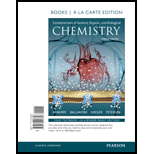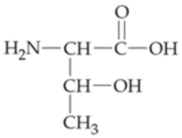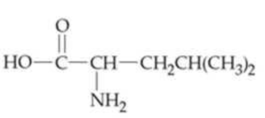
Modified Masteringchemistry With Pearson Etext -- Valuepack Access Card -- For Fundamentals Of General, Organic, And Biological Chemistry
8th Edition
ISBN: 9780134261270
Author: John E.; Ballantine, David S.; Hoeger, Carl A.; Peterson, Virginia E. Mcmurry
Publisher: Prentice Hall
expand_more
expand_more
format_list_bulleted
Concept explainers
Textbook Question
Chapter 18.3, Problem 18.5P
Indicate whether each of the following molecules is an α-amino acid or not, and explain why.




Expert Solution & Answer
Want to see the full answer?
Check out a sample textbook solution
Students have asked these similar questions
Indicate whether each of the following molecules is an alpha amino acid or not and explain why.
Identify the following amino acids and their following side chain.
Why is a string of bound amino acids called a polypeptide?
Chapter 18 Solutions
Modified Masteringchemistry With Pearson Etext -- Valuepack Access Card -- For Fundamentals Of General, Organic, And Biological Chemistry
Ch. 18.2 - Prob. 18.1PCh. 18.2 - Prob. 18.2PCh. 18.3 - Prob. 18.3PCh. 18.3 - Examine the ball-and-stick model of valine in the...Ch. 18.3 - Indicate whether each of the following molecules...Ch. 18.3 - Prob. 18.6PCh. 18.3 - Prob. 18.7KCPCh. 18.3 - Prob. 18.8PCh. 18.3 - Prob. 18.9PCh. 18.3 - Prob. 18.10P
Ch. 18.3 - Prob. 18.11PCh. 18.3 - Prob. 18.12PCh. 18.4 - The proteins collagen, bovine insulin, and human...Ch. 18.4 - Prob. 18.2CIAPCh. 18.4 - Prob. 18.13PCh. 18.4 - Prob. 18.14PCh. 18.5 - Valine is an amino acid with a nonpolar side...Ch. 18.5 - Tripeptides are composed of three amino acids...Ch. 18.5 - Prob. 18.17PCh. 18.5 - Identify the amino acids in the following...Ch. 18.5 - Prob. 18.19PCh. 18.5 - Prob. 18.3CIAPCh. 18.5 - Prob. 18.4CIAPCh. 18.5 - Two of the most complete (balanced) proteins...Ch. 18.6 - Prob. 18.6CIAPCh. 18.6 - Prob. 18.7CIAPCh. 18.6 - (a)What atoms are present in a planar unit in a...Ch. 18.6 - Prob. 18.21PCh. 18.6 - Prob. 18.22PCh. 18.7 - Prob. 18.23PCh. 18.7 - Prob. 18.24PCh. 18.7 - Complete the following two sentences with either...Ch. 18.7 - Prob. 18.26KCPCh. 18.8 - Which of the following pairs of amino acids can...Ch. 18.8 - Look at Table 18.3 and identify the type of...Ch. 18.8 - In Figure 18.3, identify the amino acids that have...Ch. 18.8 - Prob. 18.30PCh. 18.9 - Prob. 18.31PCh. 18.10 - Another endoprotease is trypsin. Trypsin...Ch. 18.10 - Prob. 18.33PCh. 18.10 - Prob. 18.8CIAPCh. 18.10 - Prob. 18.9CIAPCh. 18 - Draw the structure of the following amino acids,...Ch. 18 - Prob. 18.35UKCCh. 18 - Prob. 18.36UKCCh. 18 - Prob. 18.37UKCCh. 18 - Prob. 18.38UKCCh. 18 - Threonine has two chiral centers. Draw L-threonine...Ch. 18 - Name four biological functions of proteins in the...Ch. 18 - Prob. 18.41APCh. 18 - Prob. 18.42APCh. 18 - Prob. 18.43APCh. 18 - Prob. 18.44APCh. 18 - Prob. 18.45APCh. 18 - Prob. 18.46APCh. 18 - Prob. 18.47APCh. 18 - Draw leucine and identify any chiral carbon atoms...Ch. 18 - Prob. 18.49APCh. 18 - Prob. 18.50APCh. 18 - Is histidine hydrophilic or hydrophobic? Explain...Ch. 18 - Prob. 18.52APCh. 18 - At neutral pH, which of the following amino acids...Ch. 18 - Prob. 18.54APCh. 18 - Prob. 18.55APCh. 18 - Prob. 18.56APCh. 18 - Prob. 18.57APCh. 18 - Proteins are usually least soluble in water at...Ch. 18 - Prob. 18.59APCh. 18 - Prob. 18.60APCh. 18 - Prob. 18.61APCh. 18 - Prob. 18.62APCh. 18 - Prob. 18.63APCh. 18 - (a)Identify the amino acids present in the peptide...Ch. 18 - Prob. 18.65APCh. 18 - Prob. 18.66APCh. 18 - Prob. 18.67APCh. 18 - Prob. 18.68APCh. 18 - Prob. 18.69APCh. 18 - Prob. 18.70APCh. 18 - Prob. 18.71APCh. 18 - Prob. 18.72APCh. 18 - Prob. 18.73APCh. 18 - Prob. 18.74APCh. 18 - Prob. 18.75APCh. 18 - What kind of bond would you expect between chains...Ch. 18 - Is the bond formed between each pair in Problem...Ch. 18 - Prob. 18.78APCh. 18 - Prob. 18.79APCh. 18 - Prob. 18.80APCh. 18 - Prob. 18.81APCh. 18 - Prob. 18.82APCh. 18 - Prob. 18.83APCh. 18 - Prob. 18.84APCh. 18 - Prob. 18.85APCh. 18 - Prob. 18.86APCh. 18 - Prob. 18.87APCh. 18 - Prob. 18.88APCh. 18 - Give an example of a protein that has quaternary...Ch. 18 - Prob. 18.90APCh. 18 - Prob. 18.91APCh. 18 - Prob. 18.92APCh. 18 - Prob. 18.93APCh. 18 - Prob. 18.94APCh. 18 - Prob. 18.95APCh. 18 - Prob. 18.96APCh. 18 - Prob. 18.97APCh. 18 - Prob. 18.98CPCh. 18 - Prob. 18.99CPCh. 18 - Prob. 18.100CPCh. 18 - Prob. 18.101CPCh. 18 - Prob. 18.102CPCh. 18 - Prob. 18.103CPCh. 18 - Prob. 18.104CPCh. 18 - Prob. 18.105CPCh. 18 - Prob. 18.106CPCh. 18 - Prob. 18.107CPCh. 18 - Prob. 18.108CPCh. 18 - Prob. 18.109GPCh. 18 - Prob. 18.110GPCh. 18 - Prob. 18.111GPCh. 18 - Prob. 18.112GP
Knowledge Booster
Learn more about
Need a deep-dive on the concept behind this application? Look no further. Learn more about this topic, biochemistry and related others by exploring similar questions and additional content below.Similar questions
- Describe the basic general structure of an l-a-amino acid,and draw its structurearrow_forwardIndicate whether each of the following amino acids is polar: a. lysine b. tyrosine c. leucine d. asparagine e. proline f. cysteine g. glutamic acid h. valine i. histidine j. glycinearrow_forwardAre all the amino-acids soluble in water? Explain why?arrow_forward
- Identify each corresponding names of the amino acidsarrow_forwardWhat amino acid is technically not an amino acid and which amino acid contains no chiral carbon atoms?arrow_forwardConsider the peptide L-E-T-S-P-R-A-Y Which amino acid(s) is/are basic? A. Y B. P C. R D. L E. T F. S C. A H. Earrow_forward
- identify an amino acid that contains an alcohol side chain (complete name)arrow_forwardWhich of the following amino acids is most likely to be found on the outside of a soluble protein, and which of them is more likely to be found on the inside? Explain each answer. (Hint: Consider the effect of the amino acidside chain in each case and that the protein is folded up into its globular form.)(a) Valine (b) Aspartate(c) Histidine (d) Alaninearrow_forwardIn each of the following two groups of amino acids, which amino acid would be the easiest to distinguish from the other two amino acids in the group, based on a titration? (a) gly, leu, lys (b) glu, asp, serarrow_forward
arrow_back_ios
arrow_forward_ios
Recommended textbooks for you

Macromolecules | Classes and Functions; Author: 2 Minute Classroom;https://www.youtube.com/watch?v=V5hhrDFo8Vk;License: Standard youtube license